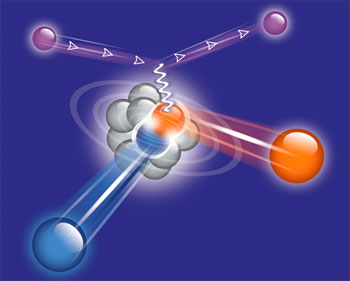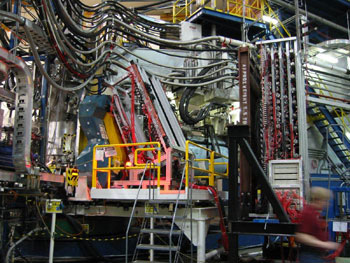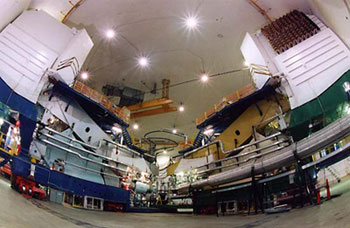Opposites attract and likes repel, or so the saying goes. That is the case in magnetism, where two bar magnets will only link up with the north end of one facing the south of the other.
But where the nucleus of the atom is concerned, the quirky laws of physics are a little different. There, an attraction between the positively charged proton and the neutral neutron holds the nucleus together.
Sometimes, a proton and a neutron may get even closer, forming a brief pairing, a phenomenon known as a short-range correlation. A proton can also pair with another proton and a neutron can pair with another neutron. For simplicity, scientists refer to both protons and neutrons as nucleons.
Oddly enough, these pairs of nucleons are the main source of high velocity nucleons in nuclei. It's thought that when the nucleons get too close, they violently repel each other, each one flying off at high speed in opposite directions.
"We've known for a very long time that there are nucleons that are moving very fast in the nucleus. It's a kind of puzzle in nuclear physics, how these fast nucleons acquire their high velocity," said Piasetzky. "One resolution was that they were going very fast because they were getting very close to each other, and we wanted to check this."
Previous experiments at JLab have shown that roughly one-fifth of all nucleons in the nucleus were in a short-range correlation. To learn more, Piasetzky and his colleagues, following a theoretical prediction by Mark Strikman and Leonid Frankfurt, set out to directly and simultaneously measure the constituents of the short-range correlations.
The experiment was conducted in Jefferson Lab's Hall A. In the experiment, a beam of energetic electrons was sent into a thin sheet of carbon. The scientists were interested in the electrons that struck protons engaged in a short-range correlation.

An electron interacts with a proton in a short-range correlation. The struck proton and its partner fly out of the nucleus. Graphic: Amma Shneor.
The deflected electrons and struck protons were measured in Hall A's High Resolution Spectrometers. The partners in each short-range correlated pair, protons or neutrons, were measured in the BigBite large acceptance spectrometer and a neutron detector.
"These correlated nucleons have a high relative momentum. If you knock one out one way, the correlated nucleon will fly out in the opposite direction," noted JLab Staff Scientist Doug Higinbotham. "We set up our detectors to take advantage of this."
The experiment found that for almost every high momentum proton kicked out of the nucleus, there was also a nucleon detected in the opposite direction. That means that the main reason for nucleons having high momentum is the fact that they are member of a correlated pair.
Moreover, most of the protons kicked out were accompanied with neutrons going in the opposite direction. The experiment showed that there are 18 times more short-range correlation neutron/proton pairs than proton/proton pairs in a carbon nucleus. The carbon nucleus has an equal number of protons and neutrons.
"It shows, for the first time in a very clear and unambiguous way, this fact that the large momentum nucleons in nuclei are coming in pairs. And they're coming mainly in proton/neutron pairs," said Eli Piasetzky.
Higinbotham agreed. "The result from this experiment is like finding that missing piece needed to finish a puzzle. This experiment, combined with others, gives us a very coherent picture of these short-range correlations in the nucleus."

Correlated protons and neutrons were measured in the BigBite large acceptance spectrometer (blue/gold magnet with detector package) and a neutron detector (tall assembly at right).
Calculations of this effect in recent theoretical work by Misak Sargsian et al. and Rocco Schiavilla et al. indicate that it is robust and does not depend on the exact parameterization of the force between nucleons, the type of the nucleus, or the exact ground-state wave-function used to describe the nucleons.
When combined with a theoretical calculation of the effects of proton/neutron correlations on the momentum distribution of the nucleons in neutron stars, the result also indicates that the presence of short-range correlations may have a disproportionately large effect on neutron star structure.
Now the collaboration is looking to extend their studies of short-range correlations.
"We want to push to the limit where they start repelling each other and try to understand this – to see what happens to two nucleons when they are even closer," Piasetzky said.
The experiment collaboration includes more than 60 members from 31 national and international institutions. The collaboration was led by Doug Higinbotham and Steve Wood (JLab.), Shalev Gilad (MIT), John Watson (KSU) and Eli Piasetzky (Tel Aviv U.). Three graduate students: Peter Monaghan (MIT), Ran Shneor (Tel Aviv U.), and Ramesh Subedi (KSU) analyzed the data as part of their Ph.D. theses. This work was supported by the U.S. Department of Energy; the U.S. National Science Foundation; the Israel Science Foundation; the US-Israeli Bi-national Scientific Foundation; the UK Engineering and Physical Sciences Research Council and the Science & Technology Facilities Council.
The paper was published online by the journal Science, at the Science Express website, on Thursday, 29 May, 2008. About Science Express from its website: Each week we select several papers for online publication in PDF format within two weeks of acceptance. For authors, it's a chance to get their peer-reviewed results in front of the scientific community as much as four to six weeks before they would otherwise appear in print. For readers, it's an opportunity to connect with these hot results immediately.
Further Reading
BigBite does its stuff


